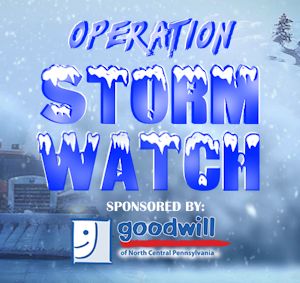
Harrisburg, PA – The Wolf Administration is urging the public to consider how COVID-19 could change or alter emergency preparedness plans leading into summer, when we face the threat of severe weather that comes with warmer weather.
“The Atlantic hurricane season started just last week and while Pennsylvania doesn’t often take a direct hit like coastal states, we face weather systems that can cause flooding or significant power outages,” said PEMA Executive Deputy Director Jeff Thomas. “The reality of COVID-19 will change the way people plan for emergencies, and the time to think about those changes is now, not in the middle of an emergency.”
Thomas said that families should review their emergency kits and plans. Emergency kits should be updated with COVID-19 necessities such as cloth masks, hand sanitizer, and medication.
Additionally, if Pennsylvanians plan to host friends or family who evacuate their homes for any reason, they should consider the need for additional emergency supplies, and plan for physical distancing measures to protect family or vulnerable loved ones.
Emergency managers, public health professionals and state, county and local officials are taking measures to reduce the possible spread of COVID-19 among people who seek safety in a disaster.
Tips to prepare to shelter from severe weather include:
• Knowing where to shelter if you do not typically shelter at home;
• Following guidance on when and where to shelter;
• Staying informed with weather alerts through cell phone alerts, a NOAA weather radio or twitter alerts; and
• Prepare an emergency kit with personal items you need in an emergency.
“Any actions to protect yourself from immediate threats to life safety should take priority, such as sheltering during severe weather,” Department of Health Deputy Secretary for Health Preparedness and Community Protection Ray Barishansky said. “However, whenever possible, all COVID-19 protective action guidance should be followed as long as it does not slow response or cause greater harm. It is essential that we act now to prepare for severe weather this summer.”
Families should have multiple ways to get severe weather alerts. A NOAA weather radio is an inexpensive and portable option that provides location-based weather alerts. Most models are battery-operated, but others can be powered via a USB connection, solar or by manually cranking a handle on the unit to store power.
Many media provide local weather alerts via text message, social media or apps that can be downloaded to a cellphone. Residents are encouraged to select one or more trusted media outlets, and sign up for the AlertPA notification system by CodeRED for emergency and weather related alerts, health notifications, building alerts, and other updates from commonwealth and federal agencies.
Keep in mind there should never be a cost for weather alerts, other than data and texting charges that may be levied by a wireless carrier.
There are five National Weather Service Offices that service Pennsylvania, and each makes weather information available via Twitter and Facebook: NWS Cleveland (Twitter, Facebook); NWS Pittsburgh (Twitter, Facebook); NWS State College (Twitter, Facebook): NWS Philadelphia/Mt. Holly (Twitter, Facebook); and NWS Binghamton (Twitter, Facebook). Users do not need a social media account to access the information shared on either platform.
For information and updates related to COVID-19, visit the Department of Health website at www.health.pa.gov or Facebook and Twitter.
More information about how to prepare for an emergency, including specific information for people with specialized needs such as pets or access and functional needs, is available on the ReadyPA webpage.
From the Ready.gov “Build a Kit” recommendations:
Build A Kit
After an emergency, you may need to survive on your own for several days. Being prepared means having your own food, water and other supplies to last for at least 72 hours. A disaster supplies kit is a collection of basic items your household may need in the event of an emergency.
Make sure your emergency kit is stocked with the items on the checklist below. Most of the items are inexpensive and easy to find and any one of them could save your life. Headed to the store? Download a printable version to take with you. Once you take a look at the basic items consider what unique needs your family might have, such as supplies for pets or seniors.
Basic Disaster Supplies Kit
To assemble your kit store items in airtight plastic bags and put your entire disaster supplies kit in one or two easy-to-carry containers such as plastic bins or a duffel bag.
A basic emergency supply kit could include the following recommended items:
Water (one gallon per person per day for at least three days, for drinking and sanitation)
Food (at least a three-day supply of non-perishable food)
Battery-powered or hand crank radio and a NOAA Weather Radio with tone alert
Flashlight
First aid kit
Extra batteries
Whistle (to signal for help)
Dust mask (to help filter contaminated air)
Plastic sheeting and duct tape (to shelter in place)
Moist towelettes, garbage bags and plastic ties (for personal sanitation)
Wrench or pliers (to turn off utilities)
Manual can opener (for food)
Local maps
Cell phone with chargers and a backup battery
Download the Recommended Supplies List (PDF)
Additional Emergency Supplies
Since Spring of 2020, the CDC has recommended people include additional items in their kits to help prevent the spread of coronavirus or other viruses and the flu.
Consider adding the following items to your emergency supply kit based on your individual needs:
Cloth face coverings (for everyone ages 2 and above), soap, hand sanitizer, disinfecting wipes to disinfect surfaces
Prescription medications
Non-prescription medications such as pain relievers, anti-diarrhea medication, antacids or laxatives
Prescription eyeglasses and contact lens solution
Infant formula, bottles, diapers, wipes and diaper rash cream
Pet food and extra water for your pet
Cash or traveler’s checks
Important family documents such as copies of insurance policies, identification and bank account records saved electronically or in a waterproof, portable container
Sleeping bag or warm blanket for each person
Complete change of clothing appropriate for your climate and sturdy shoes
Fire extinguisher
Matches in a waterproof container
Feminine supplies and personal hygiene items
Mess kits, paper cups, plates, paper towels and plastic utensils
Paper and pencil
Books, games, puzzles or other activities for children
Maintaining Your Kit
After assembling your kit remember to maintain it so it’s ready when needed:
Keep canned food in a cool, dry place.
Store boxed food in tightly closed plastic or metal containers.
Replace expired items as needed.
Re-think your needs every year and update your kit as your family’s needs change.
Kit Storage Locations
Since you do not know where you will be when an emergency occurs, prepare supplies for home, work and cars.
Home: Keep this kit in a designated place and have it ready in case you have to leave your home quickly. Make sure all family members know where the kit is kept.
Work: Be prepared to shelter at work for at least 24 hours. Your work kit should include food, water and other necessities like medicines, as well as comfortable walking shoes, stored in a “grab and go” case.
Car: In case you are stranded, keep a kit of emergency supplies in your car.














